Browse Primary Sources
Locate primary sources, including images, objects, media, and texts. Annotations by scholars contextualize sources.
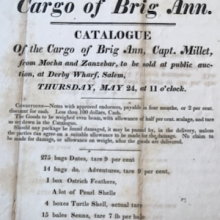
Advertisement for the Auction of the Ann’s Cargo, 1827
This flyer advertises the Ann’s 1827 arrival in Salem, Massachusetts, after making one of the first American trips to Zanzibar. The Ann’s cargo included goods that were likely procured on the island, such as ivory and gum copal, alongside wares from the Arabian Peninsula like coffee, dates, frankincense, and myrrh.
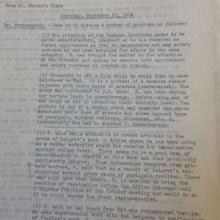
Rockefeller Foundation Report Concerning the Yellow Fever Vaccine
The creation of the yellow fever vaccine turned out to be quite controversial. Many of these controversies are revealed in documents such as this summary of correspondence between Georges Stefanopoulo, a Pastorian microbiologist, and his colleagues at the Rockefeller Foundation in New York.
"Yellow fever in Dakar – There is no epidemic"
This is an excerpt from an interview with Blaise Diagne, the Senegalese deputy to the National Assembly, published in Le Matin, one of the major national dailies in metropolitan France. The yellow fever outbreak of 1927-28 was quickly politicized by French and African commentators alike.
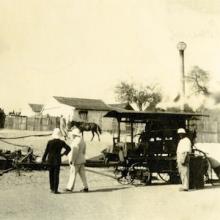
Disinfection of Dakar houses with a Clayton Apparatus
This is a photograph from the collections of the Rockefeller Archive Center depicting a Clayton apparatus disinfecting African houses during the yellow fever outbreak of 1927. The image illustrates a number of transnational linkages that shaped the epidemic. Clayton apparatuses were steam disinfection devices that used sulphuric gases to destroy pathogens in infected homes.

Nisa, The Life and Words of a !Kung Woman by Marjorie Shostak
Made up of a series of analyses and personal interviews conducted by Marjorie Shostak, Nisa, The Life and Words of a !Kung Woman is an anthropological work about women of the !Kung tribe of the Kalahari desert in southern Africa told through the perspective of one individual, Nisa.
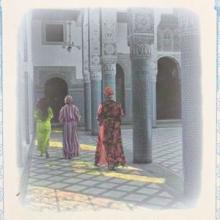
Dreams of Trespass by Fatima Mernissi
Written by Moroccan feminist and sociologist Fatima Mernissi, Dreams of Trespass: Tales of a Harem Girlhood is a semi-fictional tale about a young girl growing up in a traditional Moroccan harem in the 1940s and 1950s. The main character, self-named Fatima, observes the experiences of the women around her and their struggles with restricting patriarchal rules.
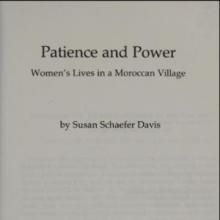
Patience and Power by Susan Davis
Patience and Power, Women's Lives in a Moroccan Village is an anthology of anecdotes, interviews, and observations by American anthropologist Dr. Susan Schaefer Davis.
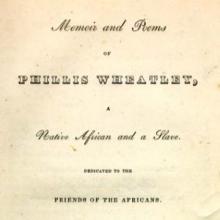
Memoirs and Poems of Phillis Wheatley
Phillis Wheatley (c.1753-1784) was an enslaved African American poet and author. Despite this, the work Memoirs and Poems of Phillis Wheatley was compiled and the memoirs themselves written by Margaretta Matilda Odell, a supposed "collateral descendent of Mrs.

Living History by Hillary Clinton
Written shortly after being elected a United States Senator, Living History is an autobiography by Hillary Rodham Clinton, politician and former First Lady of President Bill Clinton. Living History is a memoir covering Clinton's early years and her time as First Lady.

Original Manuscripts of Anne Frank
Born to a Jewish family in 1929, Anne Frank is most known for the diary she kept while in hiding from Nazi forces during World War II. The War broke out in 1939 when Anne was ten-years-old. As the measures against Jewish people in Nazi-occupied Netherlands became more brutal, the Frank family went into hiding in "the Secret Annex," a hiding place in an empty part of Otto's business, in 1942.
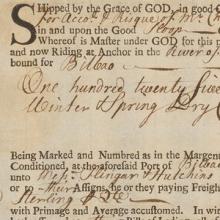
Bill of Lading of a ship from Piscataqua to Bilbao in Spain, 1721
This bill of lading is a standard form used in shipping in the 18th century. This particular bill shows the sloop (a type of wooden ship) Wren who is captained by Charles Deming carrying 125 quintals of salted cod from the River Piscataqua (near present-day Portsmouth, New Hampshire) to Bilbao in Spain.

Lisbon Port Entry List for Colonial American Ships, 1771
This is just one example of thousands of pages and documents that the Portuguese use to manage and record the trade coming in and out of their ports. The one chosen here is particularly interesting as the 7th entry (2nd from bottom) shows that an English ship has arrived and paid duties for its cargo.
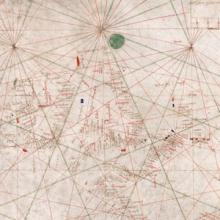
Nautical Chart, 1385
This nautical chart is signed by Majorcan cartographer Guglielmo Soler and dated to 1385, and ranges from the Black Sea to the Atlantic. Less beautiful than the Catalan map, it was also more practical for navigators to use.

Catalan Map of the World, c.1450
Dated to the mid-fifteenth century, this Catalan world map is over a meter in diameter on a sheet of vellum (high-quality parchment made of calfskin). Unlike many other surviving charts, this was not meant for practical navigation, though it was based on such nautical charts.
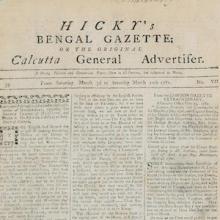
Hicky's Bengal Gazette
Hicky’s Bengal Gazette was the first printed newspaper to be published in India. While the cartoon of Henry Dundas alluded to governmental control over the flow of information between Britain and Bengal, newspapers such as Hicky’s Bengal Gazette served as an alternative and public venue for the circulation of information and even the expression of anti-government views.

Cartoon Depicts Debate at Hasting's Impeachment Trial, 1788
Printed in London in 1788, this satirical print was a response to the debate unleashed by the impeachment trial of Warren Hastings, the former and first Governor General of India, as well as the impeachment proceedings initiated against Elijah Impey, the former and first Chief Justice of the Supreme Court of Judicature in Calcutta, Bengal.
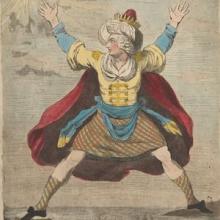
Cartoon Mocking British Policy toward India, 1788
This satirical print from 1788 constituted a cartoonist’s effort to make sense of and criticize growing governmental control over territories in South Asia. “Dun Shaw” or Henry Dundas, the British minister and leading member of the Board of Control for India Affairs is shown extending his leviathan-like self across Britain and Bengal.
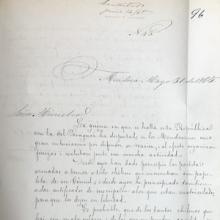
Chilean Consul Writes of Immigrants Seeking to Avoid Military Service, 1865
This document is a portion of a letter, written by José de la Cruz Zenteno, the Chilean consul in Mendoza, Argentina to the Minister of Foreign Relations in Chile is from the National Archive of Chile. Mendoza was and is an Argentinian province that borders Chile.
Chilean Consul Writes of Immigrants Needing Assistance, 1864
Found in the National Archive of Chile, this is a letter from José de la Cruz Zenteno, the Chilean consul in Mendoza, Argentina to the Minister of Foreign Relations in Chile. Mendoza was and is a province that borders Chile.
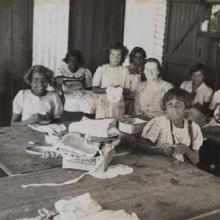
Sewing Classes at Mount Margaret Mission
These two photographs, from the State Library of Western Australia, show Aboriginal girls learning to sew from Dorothy Lovick at the Mount Margaret Mission in Laverton, Australia, in the 1930s. The first photograph shows a middle school class, while the second one features a senior class.